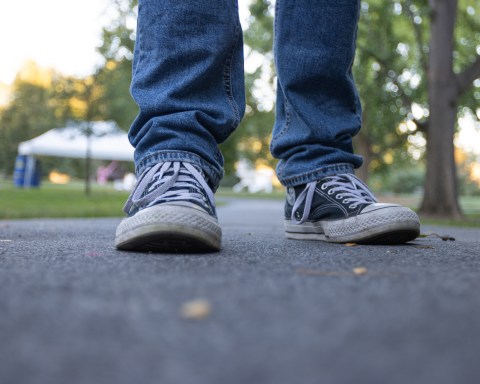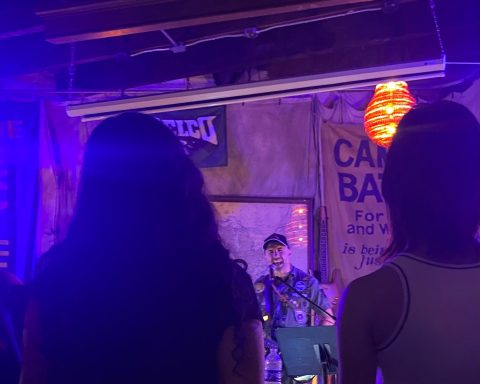Editor’s note: This article was initially published in The Daily Gazette, Swarthmore’s online, daily newspaper founded in Fall 1996. As of Fall 2018, the DG has merged with The Phoenix. See the about page to read more about the DG.
 Over fall break, a group of eight Swarthmore students traveled to Washington, D.C. to participate in the occupation at McPherson Square. The students, including Zein Nakhoda ’12, Kate Aronoff ’14, and Ben Wolcott ’14, participated in actions during the second week of October, and several of them camped out at the site. Nakhoda, a Sociology major, brought along a video camera and created a short film documenting the early activities of Occupy D.C.
Over fall break, a group of eight Swarthmore students traveled to Washington, D.C. to participate in the occupation at McPherson Square. The students, including Zein Nakhoda ’12, Kate Aronoff ’14, and Ben Wolcott ’14, participated in actions during the second week of October, and several of them camped out at the site. Nakhoda, a Sociology major, brought along a video camera and created a short film documenting the early activities of Occupy D.C.
The 22-minute film, titled A Weekend with Occupy DC, offers a glimpse of everyday life at the Occupy location. It was shot over three days and includes footage of marches, general assemblies, direct action training sessions, and street performances. The film functions primarily as an archive of what happened that weekend. Nakhoda chose not to insert his own voiceover or captions.
“I guess I leave a lot unsaid, myself, and hope that the content itself will spark dialogue and be a platform for people bringing in their other experiences,” said Nakhoda.
 “Hopefully it will serve as the start of more ongoing discussion and debate. And for people who couldn’t — or didn’t —have the inclination to visit any of the sites, or for people who haven’t been involved in similar activism, hopefully it gives an impression and maybe a slight introduction to what actually goes on. And then for people who have been involved a lot, hopefully it will be a chance for self-reflection,” he said.
“Hopefully it will serve as the start of more ongoing discussion and debate. And for people who couldn’t — or didn’t —have the inclination to visit any of the sites, or for people who haven’t been involved in similar activism, hopefully it gives an impression and maybe a slight introduction to what actually goes on. And then for people who have been involved a lot, hopefully it will be a chance for self-reflection,” he said.
Aronoff, who participated in several marches that weekend and volunteered on site, believes the film does a good job of illustrating the day-to-day activities of those involved in the movement.
“[The film shows] that Occupy is full of people doing serious political work, but who are also trying to create a strong, prefigurative community and get to know the people around them,” said Aronoff.
In making the documentary, Nakhoda aimed to create something reflective of the movement’s communal approach. He licensed the film under Creative Commons in order to encourage others to remix, tweak, and build upon his work.
“I really appreciated the collaborative way in which Zein approached the documentary,” said Wolcott, recalling a group screening Nakhoda held last semester in Beardsley’s Media Center. “He was looking to get feedback from a lot of different people [and] was really open to any and every idea that people had.”
For Nakhoda, the process of actively listening to others is at the core of the Occupy Movement. When asked about the purpose of Occupy D.C., he responded:
 “There are people at the occupations who are goal-oriented and ends-oriented and looking to see what an occupation or the movement can achieve. But there are also a lot of people at the occupations who see that kind of thing as kind of arbitrary. And I don’t think that means that they’re there aimlessly… There is enough meaning and significance that comes from working collectively and building a community that is important in its own right.”
“There are people at the occupations who are goal-oriented and ends-oriented and looking to see what an occupation or the movement can achieve. But there are also a lot of people at the occupations who see that kind of thing as kind of arbitrary. And I don’t think that means that they’re there aimlessly… There is enough meaning and significance that comes from working collectively and building a community that is important in its own right.”
Wolcott agrees and says that Nakhoda’s appreciation for community building is evident in the film.
“Occupy is both a protest and a celebration,” says Wolcott. “Occupy is creating something new, it’s trying to envision a new society. And oftentimes, given that our media is trying to figure out ‘the point,’ what’s the end, what’s the goal of anything, they lose the celebration — they lose the life and the vibrancy.”
 Nakhoda, who participated in Swarthmore’s General Assembly last semester, says he would like to see more creative activism on campus in the coming year. This fall, he participated in the creation of Swarthmore’s most recent Overlaps publication, Who Are the 99%?, which focuses on the Occupy Movement and may be read online free of charge. Nakhoda is pursuing a Film and Media Studies minor and hopes to participate in further anti-oppression efforts through media, including community-based video work with other Swarthmore students.
Nakhoda, who participated in Swarthmore’s General Assembly last semester, says he would like to see more creative activism on campus in the coming year. This fall, he participated in the creation of Swarthmore’s most recent Overlaps publication, Who Are the 99%?, which focuses on the Occupy Movement and may be read online free of charge. Nakhoda is pursuing a Film and Media Studies minor and hopes to participate in further anti-oppression efforts through media, including community-based video work with other Swarthmore students.
“[I’m interested in] who’s speaking and who’s being seen,” says Nakhoda. “The importance of representation and the difference that identity brings to all kinds of social situations, including occupations. Anti-oppression is the term that I would use — how to bring anti-oppression work into spaces. I think that’s very important.”
















We are so lucky to have a media making master like Zein! Thanks for the coverage Kat!!!
We’ve got some amazing Swatties — Zein and Kat included!